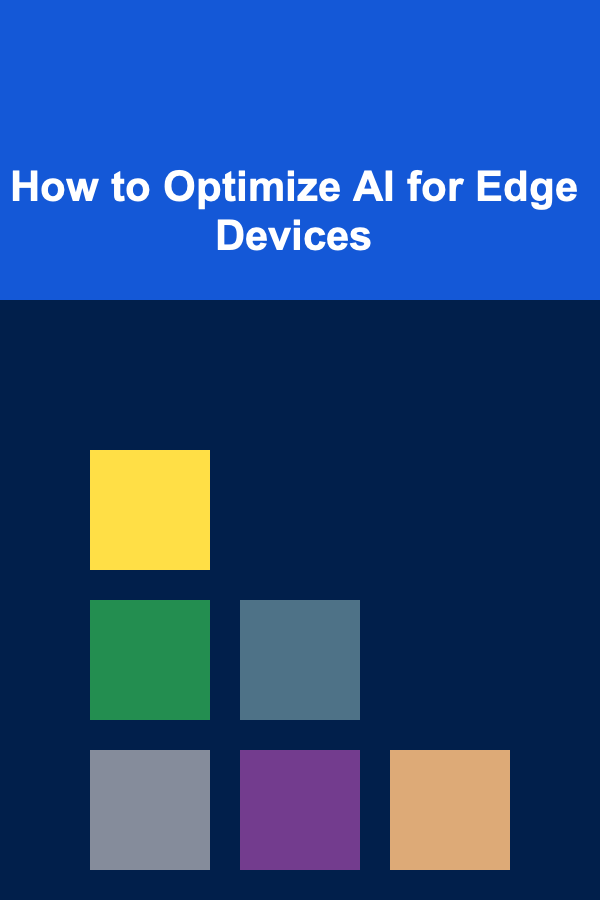
How to Optimize AI for Edge Devices
ebook include PDF & Audio bundle (Micro Guide)
$12.99$9.99
Limited Time Offer! Order within the next:

The rapid advancement of artificial intelligence (AI) and edge computing is transforming industries worldwide, from autonomous vehicles to industrial automation and healthcare. Edge devices, equipped with AI capabilities, are becoming increasingly important for real-time decision-making, improving efficiency, reducing latency, and minimizing dependency on centralized cloud computing. As AI continues to push boundaries in terms of complexity and sophistication, optimizing AI models for edge devices is crucial to ensure their successful deployment and maximize performance.
This article explores the methods, techniques, and best practices for optimizing AI for edge devices. We will delve into various aspects, such as model size reduction, inference optimization, hardware constraints, and specific tools and frameworks designed to address these challenges. By the end of this article, readers will gain a deep understanding of how to successfully deploy AI models on edge devices, considering both performance and resource limitations.
Understanding the Challenges of AI on Edge Devices
Edge devices are computing devices such as smartphones, IoT sensors, drones, robots, or wearables, that perform computations closer to the source of data generation, rather than relying entirely on the cloud. This architecture has several advantages:
- Reduced Latency: By processing data locally, edge devices can make decisions in real-time without waiting for data transmission to the cloud and back.
- Bandwidth Savings: Sending raw data to the cloud can consume significant bandwidth. Edge devices only need to send relevant data or compressed results.
- Improved Privacy: With local data processing, edge devices ensure that sensitive data doesn't have to leave the device, helping to maintain user privacy.
- Energy Efficiency: Edge devices typically have lower power consumption compared to cloud servers, which makes them ideal for battery-powered applications.
However, AI models designed for cloud environments are not always suited for edge devices. AI models often require large amounts of memory, storage, and computational resources, which are usually unavailable on edge devices. As a result, AI models need to be optimized to fit these constraints. Below are some key challenges when implementing AI on edge devices:
- Limited Computational Power: Edge devices often have much less processing power compared to powerful cloud servers.
- Storage Constraints: Storage space is limited on edge devices, making it difficult to store large AI models.
- Energy Constraints: Many edge devices, such as IoT sensors or drones, rely on battery power, so energy consumption must be minimized.
- Real-Time Requirements: Edge devices are typically used in applications that require real-time decision-making, meaning latency must be minimized.
Given these challenges, optimization is essential to effectively run AI models on edge devices.
Key Strategies for Optimizing AI on Edge Devices
1. Model Compression and Pruning
Model compression is the process of reducing the size of an AI model, making it more efficient for deployment on edge devices. This can be achieved through several methods, with pruning being one of the most widely used techniques.
Pruning
Pruning involves removing certain weights or connections from a neural network that are deemed unnecessary for the task at hand. By eliminating these redundant parameters, the model becomes smaller and more computationally efficient.
- Weight Pruning: Involves removing weights with smaller values, which generally contribute less to the final prediction. These weights can be pruned without significantly degrading model accuracy.
- Neuron Pruning: Involves removing entire neurons or layers from the model. This can be done by analyzing which neurons contribute the least to the output.
The result is a smaller, faster model that can run more efficiently on edge devices.
Quantization
Another technique for model compression is quantization, which reduces the precision of the weights and activations in a neural network. While standard neural networks typically use 32-bit floating-point numbers, quantized models can use lower precision such as 8-bit integers or even binary values, significantly reducing the memory footprint.
- Post-Training Quantization: This involves quantizing a pre-trained model after it has been trained on high-precision data.
- Quantization-Aware Training: This technique involves training the model with quantization in mind, allowing it to better adapt to lower-precision weights and activations.
Quantization can drastically reduce both the memory and computational requirements, making models more efficient for edge devices.
2. Model Distillation
Model distillation is a technique that involves transferring knowledge from a large, complex model (the teacher model) to a smaller, simpler model (the student model). The student model is trained to mimic the outputs of the teacher model, while maintaining a much smaller size and lower computational demands.
The process of distillation typically follows these steps:
- A large, complex model is trained on the target task.
- A smaller, more lightweight model is then trained to predict the same outputs as the larger model.
- The smaller model is fine-tuned to ensure it can achieve similar performance to the larger model while operating efficiently on edge devices.
This process helps create models that can run effectively on resource-constrained edge devices while still maintaining strong performance.
3. Edge-Specific Hardware Acceleration
Incorporating hardware accelerators into edge devices can provide significant boosts to AI model inference performance. Many modern edge devices, such as smartphones, IoT devices, and robotics, come equipped with specialized hardware designed to accelerate AI computations. These hardware accelerators include Graphics Processing Units (GPUs) , Tensor Processing Units (TPUs) , and Field-Programmable Gate Arrays (FPGAs).
- GPUs are widely used for AI inference because they are designed to handle large amounts of parallel computations, which is typical of deep learning models.
- TPUs are specialized hardware accelerators developed by Google that are optimized for deep learning tasks. TPUs can significantly speed up model inference and are especially useful for edge devices in cloud-connected applications.
- FPGAs provide flexibility in terms of custom hardware configurations, which can be fine-tuned for specific AI workloads, offering both performance and power efficiency.
By leveraging these hardware accelerators, edge devices can perform AI inference tasks with significantly reduced latency and power consumption.
4. Efficient Data Management and Preprocessing
Efficient data management and preprocessing play a vital role in improving the performance of AI models on edge devices. Edge devices often deal with large volumes of data, but sending all this data to the cloud for processing can be impractical due to bandwidth constraints. Therefore, processing data locally before performing AI inference is essential.
Local Preprocessing
Edge devices can use local data preprocessing to reduce the amount of data that needs to be transmitted. This includes techniques like:
- Compression: Reducing the size of the data before transmission.
- Feature Extraction: Extracting only the most relevant features from raw data, such as sensor readings, to reduce the input size.
- Edge-based Filtering: Applying algorithms like noise reduction or smoothing directly on the edge device to refine data quality.
By preprocessing data locally, edge devices can reduce the need for transmitting large datasets to the cloud, conserving both bandwidth and power.
Edge-AI Frameworks
Many frameworks are optimized specifically for AI inference on edge devices. Some of the most widely used frameworks include:
- TensorFlow Lite: A lightweight version of TensorFlow designed for mobile and embedded devices. TensorFlow Lite allows for efficient AI inference on edge devices by providing tools for quantization, model conversion, and hardware acceleration.
- PyTorch Mobile: PyTorch's solution for deploying models on mobile and edge devices. It provides optimizations such as quantization and pruning for efficient edge deployment.
- OpenVINO: Intel's toolkit for optimizing AI models for edge devices using Intel processors. It supports model conversion, acceleration, and deployment on a range of Intel hardware, including CPUs, FPGAs, and VPUs.
- ONNX Runtime: An open-source inference engine that supports a wide variety of hardware platforms and accelerators, making it suitable for deployment on different edge devices.
These frameworks ensure that AI models are optimized for edge-specific hardware and are capable of running efficiently with minimal resource consumption.
5. Edge-Oriented AI Algorithms
Certain AI algorithms are more suitable for deployment on edge devices due to their inherent efficiency. For example, lightweight models such as MobileNet, EfficientNet, and SqueezeNet are designed to be computationally efficient, requiring fewer resources while still providing good accuracy for many AI tasks.
Additionally, spatial and temporal compression techniques such as low-rank approximations and knowledge distillation can be applied to create smaller, more efficient models that are well-suited for edge deployment.
6. Adaptive Edge AI
An emerging concept in edge AI is adaptive edge AI, where models can dynamically adjust their complexity and computational requirements based on the device's current resources. For example, if the device's battery is low, the AI model might use a more efficient, lower-precision version of itself. If the device has sufficient computational power and battery life, it can switch to a more complex model to improve accuracy.
This approach helps balance resource consumption and performance, ensuring that AI models can adapt to various operating conditions.
Conclusion
Optimizing AI for edge devices is a complex but necessary task for enabling real-time, resource-efficient AI applications. Through techniques like model compression, pruning, distillation, hardware acceleration, and local data preprocessing, AI models can be adapted to fit the constraints of edge devices. As edge computing continues to evolve, so too will the methods and tools for optimizing AI for these environments, enabling the next generation of intelligent, autonomous systems.
By leveraging the right strategies and tools, it is possible to deploy AI models that are both effective and efficient on edge devices, unlocking new possibilities in various industries. With continuous advancements in edge AI, the future holds promising potential for even more optimized, real-time AI solutions.

How to Create a Family Time Capsule for Milestones and Memories
Read More
How to Manage Transportation Logistics for Field Trips
Read More
How to Set Up a Play Area for Your Pet in Your Home
Read More
How to Understand the Business of VR
Read More
How to Make Homemade Dressings (Advanced)
Read More
How To Use Daily Planning for Success
Read MoreOther Products

How to Create a Family Time Capsule for Milestones and Memories
Read More
How to Manage Transportation Logistics for Field Trips
Read More
How to Set Up a Play Area for Your Pet in Your Home
Read More
How to Understand the Business of VR
Read More
How to Make Homemade Dressings (Advanced)
Read More